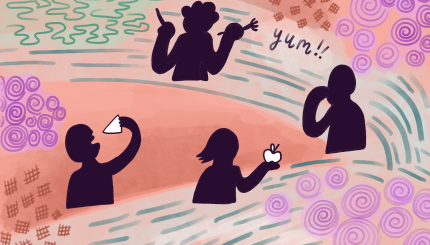Shema Yisrael Adonai Eloheinu Adonai Echad. Listen God-wrestlers, only then will you know the Oneness, the Unity.
The Shema is considered the central prayer of Judaism, spoken every morning and night, calling to us from every doorway, awakening us out of the dream of separation, calling us to consciousness of the underlying unity of all creation.
But how do we listen deeply enough to know the oneness of God? For me, that door was opened by the magic of Hebrew chanting.
For as long as I can remember, I have been fascinated by the sounds of Hebrew prayer — not just what they mean, but where they can take me. So many words buried in books seemed all but dead. But I found that if I chanted the words — if I focused in on one phrase, repeating it with a beautiful melody and a repetitive rhythm — then the words would come alive, becoming vehicles of power and healing and transporting me to expansive heights and fathomless depths. They would become incantations.
With your help, My Jewish Learning can provide endless opportunities for learning, connection and discovery.
What makes a chant different than a song? Three things: intention, repetition and awareness.
I begin with a sacred phrase that is somehow compelling, something that catches my eye, my ear, or my heart, maybe from the prayer book or the Torah. Then I allow myself to become curious and tap into my intuition. And from that intuition, I begin to build an intention. I do this by asking myself: How do I step into the state of consciousness from which those words emerged? When I embody the truth of this sacred phrase, how might my world be transformed?
As the intention builds in me, I begin repeating the phrase, listening for its melody and rhythm. Even though I have looked up the words in a dictionary and learned various ways that they are translated, I put aside what I know and just start playing — with melody, rhythm, tone, breath and movement. I allow myself to be moved and surprised.
By repeating the phrase over and over and over again, I enter into a kind of reverie. One part of me is still focused on the sound, the meaning and the intention that I am building, while another part is surrendering, transported by the beauty of the chant. All the while, I maintain a keen awareness of the transformative effect of the chant.
When I first began chanting, I was in love with sound. But after a while, I began to notice that the silence that followed the chant was simply extraordinary. I just couldn’t wait for the chant to end because I knew that I would get to dive into that beautiful silence. It was as if the chant opened a door, and in the silence I could walk through it and receive the true blessing of my efforts. I fell in love with the silence because it was there that the possibilities of transformation were fulfilled.
This movement — from sound to silence to sound to silence — eventually began to reveal the secrets of the silence at the very heart of sound, and the sound at the very heart of silence. And these secrets sent me on a path toward listening ever more deeply.
Chant is the marriage of sound and silence. In chant, they are joined in love and beauty. That love between sound and silence has the power to open me to the truth of essential unity. And the beauty of chant keeps me totally engaged and delighted.
How do you get started? Choose a sacred phrase that you love, no more than four or five words. It might be something you want to remember, or something you want to embody and live by. Or you might just love the sound of the words, the way they feel in your mouth, the way they resonate in your heart.
Once you learn the meaning of those words, begin playing with them. Close your eyes. Find a simple melody that expresses the feeling of those words and your own deepest intention. Repeat the chant for a long time. And with every repetition, ask the question, “What more can I bring?” Keep doing this until you are chanting with all your soul, heart and might.
When it’s time to enter the silence, keep your eyes closed and raise the level of your awareness. In the silence, bring all your attention to your breath and imagine that you are breathing the power of the chant directly into your heart. Stay curious and receptive as you imagine entering through a door that has just been opened. Leave the melody behind and just notice. What is different? What has been opened? What are you receiving?
Before you open your eyes, pay careful attention to the rhythm of your breath, to the sense of spaciousness within, to feelings in the body and to insights that arise. The more that you notice, the more you will benefit from the magic and power of the chant.
Chanting is a practice that our ancestors have been doing for thousands of years. They knew that it’s not enough to think about what’s true. You need to feel that truth in your body, celebrate it with your enthusiasm and be continually inspired to let the sacred words of prayer and Torah guide your life.
Rabbi Shefa Gold is a leader in ALEPH: Alliance for Jewish Renewal and is the director of C-DEEP: Center for Devotional, Energy and Ecstatic Practice in Jemez Springs, New Mexico. Her website is http://rabbishefagold.com
Want more? MJL’s “Discovering Jewish Spirituality” email series will guide you through authentic Jewish methods of bringing spirituality into your everyday experience. Sign up here.
Enhance your spirituality journey by joining our weekly Jewish Meditation Moment for a brief Jewish teaching followed by a guided meditation.



